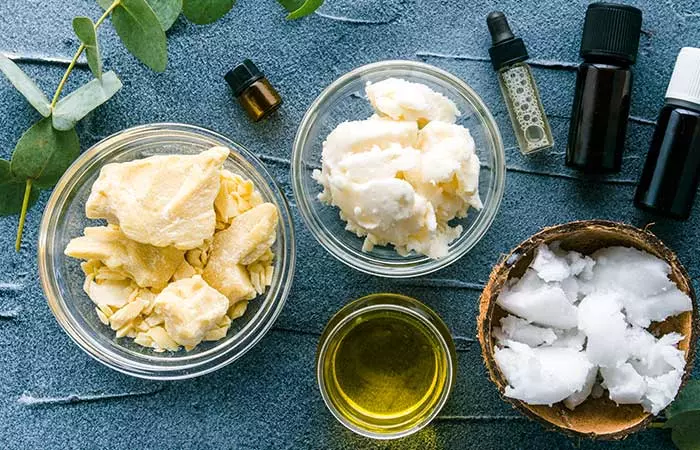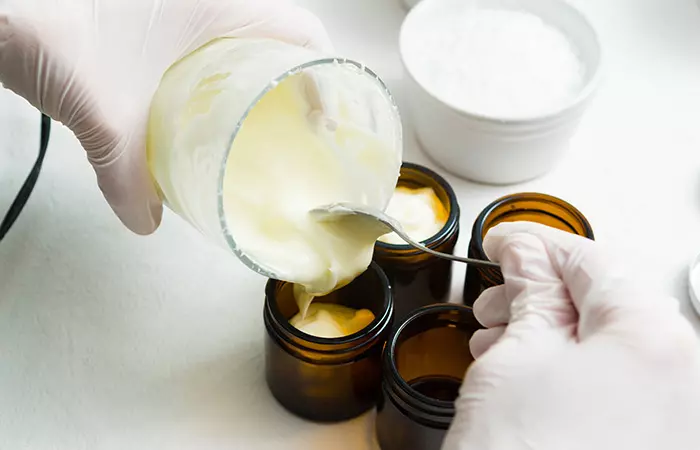All you need is a few ingredients and a little patience to have your moisturizer ready! So, are you up for it? In this article, we will look at an easy recipe to make a homemade lotion. Check it out!
Ingredients You Will Need For Homemade Lotion
The first step is to know what ingredients you need. Homemade lotions are a combination of three ingredients:
Oil Water (distilled water and not your regular tap water) Emulsifier
The consistency and texture of the lotion depend on the proportion of these three ingredients and the type of ingredients you use. Here is a breakdown of the ingredients that you will need to prepare a natural body lotion:
1. Water
Water constitutes about 70%-80% of the body lotion. Water makes the lotion thinner and easy to apply. Using only body butter and oils for your lotion will make it greasy and not give it a silky consistency.
2. Butters And Oils
Body butters and oils are rich in antioxidants, nutrients, and skin healing properties, depending on the type of oils and butter you are using. These are excellent ways to moisturize your skin and are especially beneficial for extremely dry skin. They can also help reduce the appearance of fine lines and wrinkles. The most common oils and butters used for making lotions include:
Shea butter Cocoa butter Sweet almond oil Avocado oil Sunflower oil
3. Emulsifiers And Wax
You cannot mix oils/butter with water. Emulsifiers (or emulsifying wax) help you mix and stabilize both. Emulsifiers contain components that can work with both water and oils. They act as glues to bind them together in your DIY lotion. DIY body lotions use only 10% or less of emulsifiers. Remember, you can’t use any wax, such as beeswax or candelilla wax, for making lotions. These will not act as emulsifiers. Depending on the type of emulsifier you are using, the texture of your lotion will vary. Some of the common emulsifiers that are available on the market include:
1. Emulsifying Wax
This is a plant-based emulsifier and can constitute 3%-5% of the total recipe.
2. Polawax Emulsifying Wax
This emulsifying wax can constitute 3%-6% of the total weight of your lotion recipe.
3. BTMS 50
This vegetable-based emulsifying wax can be used at 1%-15% of the total weight of your lotion recipe.
4. Olivem 1000
This is derived from the olive tree and can be used at 1.5%-3% of the total weight of the recipe if it is a light lotion and at 3%-8% of the total weight if it is a thick lotion. Using water in your lotion makes it easy to apply. But, it also turns your lotion into a breeding ground for bacteria and molds, leading to contamination. Ina, a blogger, shares her DIY Dream Cream recipe. She emphasizes the use of the main ingredients to provide the skin with the moisture it deserves. She mentions, “This DIY version is not that hard to make, with simple ingredients and not a single wax in sight,” making it an accessible and effective DIY body lotion. (i) Keeping the lotion inside the refrigerator is not going to prevent bacteria and mold unless you use a preservative.
Preservatives For Homemade Lotion
The word “preservative” might sound scary, and you might think it kills the very purpose of making a natural body lotion. Don’t worry, you will find natural preservatives that can give your homemade lotion a shelf life of 2-3 months. A few mild and natural preservatives that you can use include Leucidal, Rokonsal, and Geogard 221 (Cosgard). They are all approved by ECO-CERT. A lot of people and DIY enthusiasts believe that coconut oil, essential oils, vitamin E, and potassium sorbate act as natural preservatives for homemade lotions and other skin care products. Although these ingredients may have antibacterial or antifungal properties, they cannot prevent bacteria and mold. Vitamin E oil and grapefruit seed extracts may slow down the rancidity of the oils in your lotion, but they cannot prevent molding. On the other hand, potassium sorbate does not prevent bacteria formation in the lotion. Hence, it is important to use a preservative in any homemade skin care product (if you wish to store it for over a month). Apart from these, you will need colors (water-soluble ones) and additives, such as glycerin or fragrances. However, these are optional. Now, let’s move on to the recipe for your DIY lotion.
Homemade Lotion Recipe
65 mL distilled water (you may use floral water or distillates or the same amount of pure aloe vera gel instead of distilled water) 30 mL oil (pick any oil of your choice, such as jojoba, sweet almond, grapeseed coconut, or avocado oil) 4 grams of emulsifying wax 3 drops of lactic acid 0.6 grams of Rokonsol or 3.5 grams of Leucidal
0.5% of fragrance Glycerin (less than 5% of the total recipe) or Vitamin E oil Hyaluronic acid (2% of the total recipe) 10 drops of 100% pure essential oil of your choice
Note: You may tweak a few ingredients (except for the basic and must-have ingredients) and add oils and fragrance depending on your personal preferences. Also, use a scale or measuring cups to make sure the measurements are correct.
Method
If the pH of your lotion is higher than 5.5, and you are using Rokonsol, add a few drops of lactic acid to the mixture and test the pH. Continue once the pH is lower than 5. If you are using Leucidal, you will not need lactic acid. How can I thicken my lotion naturally? Adding melted stearic acid may help thicken the lotion naturally. Is shea butter better than lotion? A body butter (like shea butter) is more natural, thick, and better for rougher skin whereas a lotion spreads easily and absorbs to the skin better. Also, it is best to not use shea butter if you have acne-prone skin as it may clog the pores. Can I use coconut oil as lotion? You can use coconut oil to improve the hydration of the skin. However, it is best not to replace the lotion or moisturizer with coconut oil. Is oil or lotion better for massage? Oil is better for massage as it glides along well and absorbs into the skin slowly. Slow-absorbing oils are good for massages that involve repetitive movements as you need not reapply or use a lot. Discover how to make your own body lotions using butters and essential oils. Hit the play button for a detailed, step-by-step guide on creating this DIY lotion.







